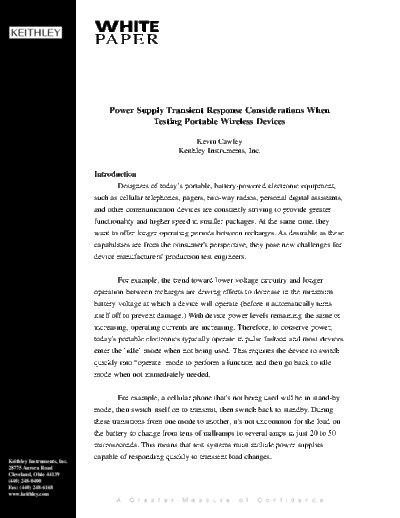Service Manuals, User Guides, Schematic Diagrams or docs for : Keithley Appnotes 2032 Power Supply WP
<< Back | HomeMost service manuals and schematics are PDF files, so You will need Adobre Acrobat Reader to view : Acrobat Download Some of the files are DjVu format. Readers and resources available here : DjVu Resources
For the compressed files, most common are zip and rar. Please, extract files with Your favorite compression software ( WinZip, WinRAR ... ) before viewing. If a document has multiple parts, You should download all, before extracting.
Good luck. Repair on Your own risk. Make sure You know what You are doing.
Image preview - the first page of the document

>> Download 2032 Power Supply WP documenatation <<
Text preview - extract from the document
WHITE
PA P E R
Power Supply Transient Response Considerations When
Testing Portable Wireless Devices
Kevin Cawley
Keithley Instruments, Inc.
Introduction
Designers of today's portable, battery-powered electronic equipment,
such as cellular telephones, pagers, two-way radios, personal digital assistants,
and other communication devices are constantly striving to provide greater
functionality and higher speed in smaller packages. At the same time, they
want to offer longer operating periods between recharges. As desirable as these
capabilities are from the consumer's perspective, they pose new challenges for
device manufacturers' production test engineers.
For example, the trend toward lower voltage circuitry and longer
operation between recharges are driving efforts to decrease in the minimum
battery voltage at which a device will operate (before it automatically turns
itself off to prevent damage.) With device power levels remaining the same or
increasing, operating currents are increasing. Therefore, to conserve power,
today's portable electronics typically operate in pulse fashion and most devices
enter the "idle" mode when not being used. This requires the device to switch
quickly into "operate" mode to perform a function and then go back to idle
mode when not immediately needed.
For example, a cellular phone that's not being used will be in stand-by
mode, then switch itself on to transmit, then switch back to standby. During
these transitions from one mode to another, it's not uncommon for the load on
the battery to change from tens of milliamps to several amps in just 20 to 50
microseconds. This means that test systems must include power supplies
Keithley Instruments, Inc.
capable of responding quickly to transient load changes.
28775 Aurora Road
Cleveland, Ohio 44139
(440) 248-0400
Fax: (440) 248-6168
www.keithley.com
A G r e a t e r M e a s u r e o f C o n f i d e n c e
Pulse Operation In Cellular Phones
To maximize the cellular phone industry's message capacity (the number of users that
can access the system in a particular cellular site), standards require phones to communicate
with the system in defined time intervals. Several different standards have been developed
around the world. The U.S. digital standard is known as the North American IS-54 Standard.
This standard utilizes a combination of frequency division multiple access (FDMA), in which
a base station assigns a mobile phone to operate at a specific 30kHz frequency band, and time
division multiple access (TDMA), in which three users share the same frequency slot by
transmitting at different time intervals. The base station assigns each user a time slot. The
IS-54 standard requires that transmissions occur in time slots of 6.67ms.
European digital communications equipment follows the Global System for Mobile
communication (GSM) standard. This standard has been adopted within most of Europe as
well as in many other countries. The GSM standard is also an FDMA/TDMA system. The
assigned frequencies have 200kHz bandwidths; however, eight users can share one frequency
allocation. As a result, each transmission time slot is a narrow 576◦ Jabse Service Manual Search 2024 ◦ Jabse Pravopis ◦ onTap.bg ◦ Other service manual resources online : Fixya ◦ eServiceinfo